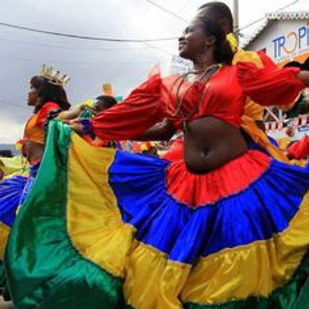The Haiti
Mission
Culture
The culture of Haiti is an eclectic mix of African, and European elements due to the French colonization of Haiti, as is evidenced in the Haitian language, music, and religion. Bright colors are very present in their culture.


ART
Brilliant colors, naïve perspective, and sly humor characterize Haitian art. Big, delectable foods and lush landscapes are favorite subjects in this land of poverty and hunger. Often they use subjects such as jungle animals, rituals, dances, and gods to show their African Culture in their artwork.
ARCHITECTURE
Haiti's most famous monuments are the Sans-Souci Palace and the Citadelle Laferrière, inscribed as a World Heritage site in 1982. Situated in the Northern Massif de la Hotte, in one of Haiti's National Parks, the structures date from the early 19th century. The buildings were among the first to be built after Haiti's independence from France. Jacmel, the colonial city that was tentatively accepted as a World Heritage site, is reported to be extensively damaged by the 2010 Haiti earthquake. Since the earthquake of 2010, Architecture has taken a huge turn. With damages at an estimated 10 million dollars, architectural measures were taken immediately. Directly after the earthquake Article 25 of the UK gained about 350 architects in 2010 looking to help rebuild Haiti. There was also great effort made by the U.S. through the Architecture for Humanity effort that was iniated after the earthquake. The architecture style became very reasonable and involved minimalistic and functional style to help rebuild the damage in the most efficient way possible. There has also been a strong iniative to build more open-air clinics that are designed with health precautions as a huge priority.


MUSIC & DANCE
Haitian music combines a wide range of influences drawn from the many people who have settled on this Caribbean island. It reflects French, African rhythms, Spanish elements and others who have inhabited the island of Hispaniola and minor native Taino influences. Styles of music unique to the nation of Haiti include music derived from Vodouceremonial traditions, Rara parading music, Twoubadou
ballads, Mini-jazz rock bands, Rasin movement, Hip hop Kreyòl, the wildly popular compas, and Méringue as its basic rhythm.
LANGUAGE
The Haitian language is a French mix called Haitian Creole. spoken by 9.6–12 million people worldwide, and the only language of more than 95% of Haitians. It is a creole language based largely on 18th-century French with influences from Portuguese, Spanish, Taíno, and West African languages. Haitian Creole emerged from contact between French settlers and African slaves during the Atlantic Slave Trade in the French colony of Saint‑Domingue (now the Republic of Haiti). Haitians are the largest creole-speaking community in the world.
